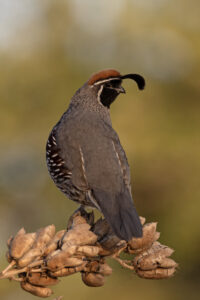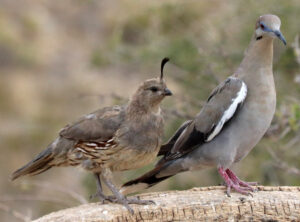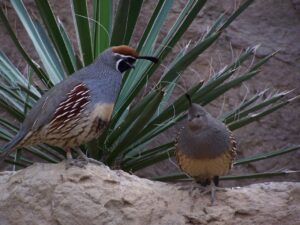Gambel’s Quail: The Complete Homestead Guide
Callipepla gambelii – The Desert Jewel

Quick Reference Stats
- Egg Production: 60-100 eggs per year
- Maturity: 20-24 weeks
- Adult Weight: 5-6 oz
- Feed Conversion: 4.5:1
- Space Required: 4-6 sq ft per bird
- Lifespan: 4-7 years
- Flight Capability: Excellent fliers, escape artists
Introduction
Gambel’s quail represents one of the Southwest’s most striking gamebirds, perfectly adapted to arid environments and known for their remarkable heat tolerance and water conservation abilities. Named after naturalist William Gambel, these birds showcase distinctive plumage patterns with bold black belly patches, chestnut flanks, and the characteristic forward-curving head plume shared with their California quail cousins.
These desert specialists offer unique opportunities for homesteaders in arid regions, combining ornamental beauty with modest production potential while requiring specialized management that reflects their adaptation to harsh desert conditions. Their ability to thrive in extreme heat and limited water availability makes them particularly valuable for sustainable agriculture in challenging climates.
Breed Overview

Physical Characteristics
Male Features:
- Head Plume: Prominent forward-curving black plume
- Facial Pattern: Bold white eyebrow and black face stripe
- Belly Marking: Distinctive black patch on cream-colored belly
- Flank Pattern: Bright chestnut sides with white striping
- Size: 5-5.5 ounces
Female Features:
- Head Plume: Smaller, less prominent plume
- Coloring: More subdued gray-brown overall
- Belly: Plain buff color without black patch
- Pattern: Less contrasting markings than males
- Size: 5.5-6 ounces
Distinguishing from California Quail:
- Belly Pattern: Black patch vs. scaled pattern
- Flank Color: Chestnut vs. olive-brown
- Habitat Adaptation: Desert vs. chaparral specialist
- Size: Slightly smaller overall
Geographic Distribution and Subspecies

Natural Range:
- Primary: Sonoran Desert region
- States: Arizona, New Mexico, Nevada, southern California
- Mexico: Northwestern states
- Elevation: Sea level to 4,500 feet
Recognized Subspecies:
- Desert Gambel’s (C. g. gambelii): Main population
- Coastal Gambel’s (C. g. fulvipectus): Southern California
- Peninsular Gambel’s (C. g. pembertoni): Baja California
- Colima Gambel’s (C. g. ridgwayi): Western Mexico
Desert Adaptations
Water Conservation:
- Kidney Efficiency: Concentrated urine production
- Metabolic Water: Derives moisture from food metabolism
- Behavioral Adaptation: Seeks shade during hottest periods
- Physiological: Reduced water loss through breathing
Heat Tolerance:
- Panting: Efficient cooling mechanism
- Plumage: Light-colored feathers reflect heat
- Activity Patterns: Crepuscular feeding to avoid heat
- Shelter Seeking: Expert at finding cooling spots
Housing Requirements
Climate-Specific Design
Desert Environment Considerations:
- Extreme Heat: Summer temperatures exceeding 110°F
- Cold Snaps: Winter lows below freezing
- Low Humidity: Often less than 20% relative humidity
- UV Exposure: Intense solar radiation
- Dust Storms: Frequent wind-blown particles
Essential Housing Features:
- Shade Structures: Multiple covered areas throughout pen
- Wind Protection: Barriers against dust storms and cold winds
- Ventilation: Air movement without draft exposure
- Drainage: Rapid water runoff during rare heavy rains
- UV Protection: Covering from intense desert sun
Space and Facility Requirements
Minimum Standards:
- Floor Space: 4 square feet per bird minimum
- Recommended: 6-8 square feet per bird optimal
- Height: 8-10 feet to accommodate strong flight
- Covey Size: 12-20 birds per large flight pen
Specialized Desert Housing:
- Cooling Systems: Evaporative cooling or misting
- Insulation: Reflective materials to reduce heat gain
- Multiple Shelters: Various cooling options throughout day
- Water Features: Shallow pools or dripping systems
- Substrate: Sand or decomposed granite for natural feel
Predator Protection in Desert Environment
Desert Predators:
- Aerial: Hawks, owls, ravens
- Terrestrial: Coyotes, foxes, bobcats, ringtails
- Reptilian: Snakes (rattlesnakes, king snakes)
- Small Mammals: Pack rats, ground squirrels
Protection Strategies:
- Overhead Coverage: Mesh or solid roofing
- Underground Barriers: Hardware cloth buried 18 inches
- Visual Barriers: Brush piles and hiding spots
- Lighting: Motion-activated deterrent systems
- Perimeter Security: Double fencing systems
Environmental Management
Temperature Control
Summer Management:
- Cooling Systems: Evaporative coolers, misters, fans
- Shade Provision: 75% pen coverage minimum
- Water Availability: Multiple sources, temperature monitoring
- Activity Scheduling: Feed during cooler morning/evening hours
Winter Management:
- Wind Protection: Solid barriers against cold winds
- Shelter Access: Insulated roosting areas
- Water Heating: Prevent freezing in waterers
- Nutrition Boost: Higher calorie feeds for energy
Humidity and Ventilation
Low Humidity Adaptation:
- Natural Tolerance: Adapted to 10-30% humidity
- Respiratory Health: Monitor for dust-related issues
- Feather Condition: Dust baths for maintenance
- Water Balance: Careful monitoring of hydration
Ventilation Requirements:
- Air Movement: Gentle circulation without drafts
- Dust Control: Filters and regular cleaning
- Temperature Regulation: Heat exchange systems
- Fresh Air: Adequate oxygen supply
Seasonal Challenges
Monsoon Season (July-September):
- Humidity Spikes: Sudden increases to 60-80%
- Flash Flooding: Drainage system requirements
- Fungal Issues: Increased disease pressure
- Temperature Swings: Rapid day-to-night changes
Winter Weather:
- Freezing: Occasional temperatures below 32°F
- Wind Storms: Cold, dry winds
- Reduced Daylight: Shortened photoperiods
- Water Freezing: Ice formation in waterers
Feeding and Nutrition
Desert-Adapted Nutrition
Natural Diet Components:
- Seeds: Desert grasses, forbs, shrub seeds
- Green Matter: Succulent plant parts, new growth
- Insects: Beetles, ants, termites, larvae
- Seasonal Foods: Cactus fruits, berries, flowers
Water Extraction:
- Succulent Plants: Barrel cactus, prickly pear
- Morning Dew: Collection from vegetation
- Metabolic Water: From seed and insect digestion
- Efficient Kidneys: Maximum water retention
Commercial Feeding Programs
Life Stage Nutrition:
- Chicks (0-8 weeks): 28-30% protein gamebird starter
- Growing (8-20 weeks): 22-24% protein developer
- Adults: 16-18% protein maintenance
- Breeding: 20-22% protein with calcium boost
Feed Selection:
- Gamebird Feed: Specially formulated, optimal choice
- Turkey Feed: Acceptable with modifications
- Waterfowl Feed: Good for adults in desert conditions
- Custom Blends: Tailored to local conditions
Water Management
Critical Importance: Despite their desert adaptation, captive Gambel’s quail require consistent water access.
Water Provision:
- Daily Amount: 1-2 ounces per bird minimum
- Multiple Sources: Various locations throughout pen
- Fresh Quality: Clean water changed daily
- Temperature: Cool water during hot weather
Water Conservation Techniques:
- Drip Systems: Minimize waste while ensuring access
- Shallow Containers: Prevent drowning, easy access
- Shade Coverage: Reduce evaporation and overheating
- Monitoring: Regular checks for adequate consumption
Seasonal Feeding Adjustments
Summer Feeding:
- Early Morning: Primary feeding before heat
- Evening: Secondary feeding after temperature drop
- Increased Water: Higher consumption during heat
- Electrolytes: Supplements during extreme heat periods
Winter Feeding:
- Higher Calories: Increase fat content by 15-20%
- Warm Water: Prevent freezing, encourage consumption
- Vitamin D: Supplement for reduced sunlight
- Consistent Schedule: Regular feeding times
Breeding and Reproduction
Breeding Season and Behavior
Natural Breeding Cycle:
- Season: March through September
- Peak: April through July
- Triggers: Increasing daylight and spring rains
- Pair Bonds: Seasonal monogamous relationships
Courtship Behavior:
- Male Displays: Elaborate posturing and calling
- Territory Defense: Males establish and guard territories
- Pair Formation: Complex courtship rituals
- Nest Site Selection: Joint decision by pair
Nesting Requirements
Natural Nesting Preferences:
- Ground Nests: Hidden under shrubs or vegetation
- Location: Near escape routes and shelter
- Construction: Simple scrape lined with vegetation
- Concealment: Well-hidden from predators and elements
Captive Nesting Management:
- Nesting Boxes: Ground-level, partially hidden
- Natural Materials: Twigs, grass, leaves for lining
- Multiple Options: Several nest sites per pair
- Privacy: Reduced disturbance during nesting
Egg Production and Incubation
Laying Characteristics:
- Clutch Size: 8-15 eggs (average 10-12)
- Laying Rate: One egg every 24-36 hours
- Annual Production: 60-100 eggs per female
- Egg Appearance: Cream colored with brown speckles
Incubation Management:
- Natural Incubation: Female incubates, male guards
- Incubation Period: 21-24 days
- Artificial Incubation: Temperature 99.5°F, humidity 60-70%
- Hatch Rate: 65-80% with proper management
Chick Development
Precocial Nature:
- Immediate Mobility: Active within hours of hatching
- Early Foraging: Begin feeding independently
- Parental Guidance: Adults teach food location and safety
- Rapid Growth: Flight capability at 2-3 weeks
Brooding in Captivity:
- Starting Temperature: 95°F
- Weekly Reduction: 5°F decrease per week
- Brooding Duration: 4-5 weeks
- Group Size: Small groups for social development
Health Management
Desert-Specific Health Challenges
Heat Stress:
- Symptoms: Panting, drooped wings, lethargy
- Prevention: Adequate shade, cooling systems, fresh water
- Treatment: Immediate cooling, electrolyte support
- Monitoring: Regular temperature and behavior checks
Dehydration:
- Risk Factors: High temperatures, low humidity, illness
- Signs: Reduced activity, sunken eyes, thick saliva
- Prevention: Multiple water sources, regular monitoring
- Treatment: Electrolyte solutions, veterinary care
Dust-Related Issues:
- Respiratory Problems: Dust pneumonia, tracheal irritation
- Eye Irritation: Dust accumulation causing inflammation
- Prevention: Dust control, proper ventilation
- Treatment: Saline flushes, antibiotics if bacterial
Common Health Problems
Parasitic Infections:
- External: Mites, lice, fleas
- Internal: Roundworms, cecal worms, coccidia
- Desert-Specific: Tick-borne diseases
- Prevention: Regular monitoring, quarantine protocols
Nutritional Disorders:
- Vitamin Deficiencies: Especially A and D in captivity
- Mineral Imbalances: Calcium/phosphorus ratios
- Water-Soluble Vitamins: B-complex deficiencies
- Prevention: Balanced commercial feeds, supplements
Environmental Stress:
- Temperature Extremes: Both heat and cold stress
- Overcrowding: Territorial disputes, aggression
- Predator Pressure: Chronic stress from threats
- Noise Pollution: Urban environment stressors
Disease Prevention
Biosecurity Protocols:
- Quarantine: 45 days for new birds
- Sanitation: Daily cleaning of water and food containers
- Vector Control: Management of flies, mosquitoes, ticks
- Facility Hygiene: Regular disinfection of housing
Vaccination Programs:
- Newcastle Disease: Recommended in most areas
- Fowl Pox: Important in mosquito-present areas
- Regional Diseases: Consult local veterinarians
- Timing: Follow manufacturer guidelines
Production Management
Meat Production
Processing Considerations:
- Optimal Age: 20-22 weeks for tender meat
- Live Weight: 5-6 ounces
- Dressed Weight: 3.5-4.5 ounces
- Meat Quality: Lean, mildly gamey flavor
Market Characteristics:
- Specialty Market: High-end restaurants
- Regional Demand: Southwest cuisine applications
- Premium Pricing: Limited availability drives value
- Processing Requirements: Licensed facilities needed
Egg Production
Laying Performance:
- First Year: 40-60 eggs per female
- Peak Years: 60-100 eggs annually
- Decline: Gradual reduction after age 4
- Seasonal Pattern: Spring through fall peak
Egg Characteristics:
- Size: Slightly smaller than chicken bantam eggs
- Color: Cream with brown speckles
- Shell Quality: Proportionally thick, strong
- Nutritional Value: High protein, rich flavor
Breeding Stock Management
Selection Criteria:
- Desert Adaptation: Heat tolerance, water efficiency
- Health: Disease resistance, vigor
- Production: Egg laying ability, fertility
- Conformation: Proper breed characteristics
Genetic Considerations:
- Bloodline Diversity: Prevent inbreeding depression
- Wild Genetics: Periodic introduction of wild genes
- Trait Selection: Focus on adaptation and production
- Record Keeping: Detailed breeding documentation
Economic Considerations
Startup Investment
Initial Costs:
- Breeding Stock: $30-60 per bird
- Housing: $35-75 per bird capacity
- Cooling Systems: $500-2000 for climate control
- Equipment: $300-800 total setup
Specialized Equipment:
- Evaporative Coolers: $200-800 each
- Misting Systems: $100-500 installation
- Shade Structures: $300-1000 construction
- Water Systems: $200-600 setup
Operating Costs
Annual Expenses:
- Feed: $35-55 per bird annually
- Utilities: $200-800 for cooling/heating
- Healthcare: $5-12 per bird
- Maintenance: $200-600 annually
Climate Control Costs:
- Summer Cooling: Significant electricity usage
- Water: Higher consumption for cooling systems
- Equipment Replacement: Harsh environment wear
- Insulation: Energy efficiency improvements
Revenue Streams
Primary Markets:
- Breeding Stock: $40-100 per pair
- Processed Birds: $18-30 each
- Hatching Eggs: $3-6 each
- Live Birds: $15-25 each
Specialty Markets:
- Desert Landscaping: Living ornamental birds
- Educational: Native species demonstrations
- Conservation: Captive breeding programs
- Research: Scientific study subjects
Market Development
Regional Advantages:
- Southwest Markets: Natural regional appeal
- Desert Tourism: Agritourism opportunities
- Native Species: Conservation value marketing
- Climate Adaptation: Drought-resistant livestock appeal
Marketing Strategies:
- Desert Adaptation: Emphasize heat tolerance
- Water Efficiency: Sustainable agriculture angle
- Native Heritage: Regional cultural connections
- Specialty Production: Premium desert gamebird
Legal and Regulatory Framework
Federal Regulations
Migratory Bird Treaty Act:
- Protected Status: Gambel’s quail are protected
- Captive-Bred Exception: Domestically raised birds exempt
- Documentation: Required for interstate commerce
- Compliance: Strict adherence to regulations
USDA Requirements:
- Health Testing: Pullorum disease testing
- Interstate Transport: Health certificates required
- Processing: Federal or state inspection needed
- Facility Standards: Minimum care requirements
State-Specific Regulations
Arizona Regulations:
- Game and Fish License: Required for commercial breeding
- Facility Inspection: Annual compliance checks
- Record Keeping: Detailed production records
- Sales Documentation: Track all bird movements
Other Southwestern States:
- New Mexico: Game breeder permits required
- Nevada: Wildlife in captivity permits
- California: Exotic bird regulations apply
- Texas: Game bird breeding licenses
Local Considerations
Zoning Requirements:
- Agricultural Zoning: Usually required
- Urban Restrictions: Often prohibited in cities
- Special Use Permits: May be needed in some areas
- Neighbor Relations: Consider noise and odor impacts
Water Rights and Usage:
- Water Allocation: Important in arid regions
- Conservation Requirements: Efficiency mandates
- Well Permits: Groundwater usage rights
- Recycling Systems: Gray water utilization
Conservation and Educational Value
Species Conservation
Habitat Preservation:
- Desert Ecosystem: Sonoran Desert protection
- Urban Development: Habitat fragmentation threats
- Climate Change: Shifting range patterns
- Captive Insurance: Genetic diversity maintenance
Research Applications:
- Desert Adaptation: Physiological studies
- Climate Resilience: Heat tolerance research
- Water Conservation: Efficiency mechanisms
- Behavior Studies: Social structure research
Educational Programs
Native Species Education:
- Desert Ecology: Adaptation demonstrations
- Water Conservation: Efficiency examples
- Climate Change: Resilience studies
- Cultural Heritage: Indigenous relationships
School Programs:
- Life Science: Biology and ecology lessons
- Geography: Desert region studies
- Environmental Science: Adaptation concepts
- Agriculture: Sustainable farming practices
Advanced Management Strategies
Behavioral Management
Natural Behavior Encouragement:
- Foraging: Scatter feeding, hidden food
- Dust Bathing: Sand areas for feather maintenance
- Social Structure: Appropriate group sizes
- Territory: Adequate space for natural behaviors
Stress Reduction:
- Environmental Enrichment: Varied habitat features
- Predictable Routine: Consistent daily schedule
- Quiet Zones: Escape areas from disturbance
- Natural Lighting: Seasonal photoperiod simulation
Breeding Program Development
Genetic Management:
- Founder Diversity: Multiple unrelated bloodlines
- Outcrossing Schedule: Regular introduction of new genetics
- Line Breeding: Develop specific traits
- Culling Programs: Remove inferior birds
Selection Objectives:
- Heat Tolerance: Extreme temperature survival
- Water Efficiency: Low water requirement strains
- Production: Improved egg laying ability
- Hardiness: Disease resistance development
Climate Adaptation Research
Heat Tolerance Studies:
- Temperature Limits: Maximum survival temperatures
- Cooling Behaviors: Natural adaptation mechanisms
- Physiological Responses: Heat stress indicators
- Breeding Selection: Heat-tolerant strain development
Water Conservation Research:
- Minimum Requirements: Lowest viable water intake
- Efficiency Mechanisms: Physiological adaptations
- Behavioral Patterns: Water-seeking behaviors
- Breeding Applications: Selection for efficiency
Troubleshooting Common Problems
Heat Stress Management
Prevention Strategies:
- Cooling Systems: Multiple cooling methods
- Shade Provision: Adequate coverage throughout day
- Water Management: Cool, fresh water availability
- Activity Timing: Feed during cooler periods
Emergency Response:
- Immediate Cooling: Move to shaded, cooled area
- Electrolyte Support: Provide electrolyte solutions
- Veterinary Care: Seek professional help if severe
- Recovery Monitoring: Watch for continued improvement
Water-Related Issues
Dehydration Prevention:
- Multiple Sources: Water available throughout pen
- Quality Maintenance: Fresh, clean water daily
- Consumption Monitoring: Track individual intake
- Environmental Factors: Shade waterers, prevent overheating
Overconsumption Problems:
- Heat Stress: Address underlying temperature issues
- Disease: Check for illness causing increased thirst
- Water Quality: Ensure palatability and cleanliness
- Behavioral Issues: Reduce stress factors
Facility Problems
Cooling System Failures:
- Backup Systems: Multiple cooling methods available
- Maintenance Schedule: Regular equipment servicing
- Temperature Monitoring: Automated alert systems
- Emergency Procedures: Rapid response protocols
Dust and Air Quality:
- Ventilation Systems: Adequate air exchange
- Dust Control: Regular cleaning, surface treatments
- Filter Maintenance: Replace air filters regularly
- Monitoring: Air quality measurement devices
Getting Started with Gambel’s Quail
Pre-Planning Phase
Climate Assessment:
- Local Conditions: Temperature and humidity patterns
- Seasonal Variations: Extreme weather preparation
- Cooling Requirements: System sizing and costs
- Water Availability: Source identification and costs
Regulatory Compliance:
- Permit Applications: Begin process early
- Facility Requirements: Understand standards
- Inspection Preparation: Meet all requirements
- Documentation Systems: Record-keeping setup
Facility Development
Construction Planning:
- Site Selection: Optimal location for desert conditions
- Phase Construction: Build in manageable stages
- Climate Systems: Install before bird arrival
- Testing Period: Ensure all systems function properly
Equipment Installation:
- Cooling Systems: Evaporative coolers, misters
- Shade Structures: Permanent and movable options
- Water Systems: Multiple sources and backup
- Monitoring Equipment: Temperature and humidity tracking
Initial Flock Establishment
Stock Selection:
- Reputable Sources: Established breeders with health records
- Health Certification: Disease testing and health guarantees
- Genetic Diversity: Unrelated breeding lines
- Age Considerations: Young adults for longevity
Acclimation Process:
- Gradual Introduction: Slow adaptation to new environment
- Stress Monitoring: Watch for adaptation problems
- Health Observation: Daily monitoring during transition
- System Adjustment: Fine-tune facility based on bird response
Conclusion
Gambel’s quail offer desert homesteaders a unique opportunity to work with one of the Southwest’s most perfectly adapted gamebirds. Their remarkable heat tolerance, water conservation abilities, and striking beauty make them valuable additions to sustainable agriculture operations in arid regions.
Success with Gambel’s quail requires understanding and working with their desert adaptations rather than against them. Their specialized needs for cooling, water management, and predator protection in harsh environments demand higher initial investments and ongoing attention to environmental controls, but the rewards include working with birds that showcase millions of years of desert evolution.
The conservation value of maintaining captive populations of these native desert specialists adds significance beyond simple production goals. As climate change and habitat loss continue to pressure wild populations, well-managed captive flocks serve as genetic reservoirs and educational ambassadors for desert ecosystem conservation.
For homesteaders committed to mastering the unique challenges of desert gamebird management, Gambel’s quail provide an opportunity to develop expertise with truly specialized livestock while contributing to the preservation of one of North America’s most beautifully adapted desert species. Their combination of ornamental value, modest production potential, and conservation significance makes them worthy subjects for dedicated desert agriculture enthusiasts.


